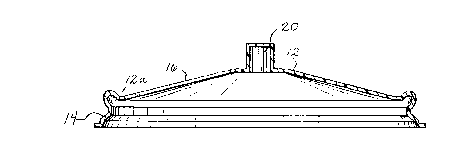Some of the information on this Web page has been provided by external sources. The Government of Canada is not responsible for the accuracy, reliability or currency of the information supplied by external sources. Users wishing to rely upon this information should consult directly with the source of the information. Content provided by external sources is not subject to official languages, privacy and accessibility requirements.
Any discrepancies in the text and image of the Claims and Abstract are due to differing posting times. Text of the Claims and Abstract are posted:
| (12) Patent Application: | (11) CA 2209833 |
|---|---|
| (54) English Title: | DRINK-THROUGH LID FOR CONTAINER |
| (54) French Title: | COUVERCLE OUVRANT POUR CONTENANT A BOIRE |
| Status: | Deemed Abandoned and Beyond the Period of Reinstatement - Pending Response to Notice of Disregarded Communication |
| (51) International Patent Classification (IPC): |
|
|---|---|
| (72) Inventors : |
|
| (73) Owners : |
|
| (71) Applicants : |
|
| (74) Agent: | BORDEN LADNER GERVAIS LLP |
| (74) Associate agent: | |
| (45) Issued: | |
| (22) Filed Date: | 1997-07-08 |
| (41) Open to Public Inspection: | 1998-01-30 |
| Availability of licence: | N/A |
| Dedicated to the Public: | N/A |
| (25) Language of filing: | English |
| Patent Cooperation Treaty (PCT): | No |
|---|
| (30) Application Priority Data: | ||||||
|---|---|---|---|---|---|---|
|
A container lid includes a flap region that is selectively displaceable
between a static raised position and a static depressed position. A flap is cut out
of the flap region and is substantially integral with the flap region when the flap
region is in the static raised position. When the flap region is displaced to the
static depressed position, the flap separates from the flap region enabling liquid
to flow therethrough. When the flap region is returned to the static raised
position, the flap is again substantially integral with the flap region to thereby
close the lid and prevent liquid from escaping. A knob is provided preferably
integral with the flap region to facilitate displacement of the flap region.
Cette invention concerne un couvercle de contenant comportant une partie mobile entre une position relevée et une position abaissée. Une pièce découpée dans la partie mobile est en majeure partie solidaire de la partie mobile lorsque celle-ci est relevée. Lorsque la partie mobile est abaissée, la pièce découpée se désolidarise de la partie mobile pour permettre l'écoulement du liquide contenu dans le contenant. Lorsque la partie mobile est relevée à nouveau, la pièce découpée redevient sensiblement solidaire de cette partie et obture alors le couvercle pour empêcher le liquide de s'échapper. De préférence, un bouton solidaire de la partie mobile est prévu pour faciliter le déplacement de cette partie.
Note: Claims are shown in the official language in which they were submitted.
Note: Descriptions are shown in the official language in which they were submitted.

2024-08-01:As part of the Next Generation Patents (NGP) transition, the Canadian Patents Database (CPD) now contains a more detailed Event History, which replicates the Event Log of our new back-office solution.
Please note that "Inactive:" events refers to events no longer in use in our new back-office solution.
For a clearer understanding of the status of the application/patent presented on this page, the site Disclaimer , as well as the definitions for Patent , Event History , Maintenance Fee and Payment History should be consulted.
| Description | Date |
|---|---|
| Inactive: IPC from MCD | 2006-03-12 |
| Application Not Reinstated by Deadline | 2002-07-08 |
| Time Limit for Reversal Expired | 2002-07-08 |
| Deemed Abandoned - Failure to Respond to Maintenance Fee Notice | 2001-07-09 |
| Application Published (Open to Public Inspection) | 1998-01-30 |
| Classification Modified | 1997-11-06 |
| Inactive: IPC assigned | 1997-11-06 |
| Inactive: First IPC assigned | 1997-11-06 |
| Filing Requirements Determined Compliant | 1997-09-17 |
| Letter Sent | 1997-09-17 |
| Inactive: Filing certificate - No RFE (English) | 1997-09-17 |
| Application Received - Regular National | 1997-09-16 |
| Abandonment Date | Reason | Reinstatement Date |
|---|---|---|
| 2001-07-09 |
The last payment was received on 2000-06-23
Note : If the full payment has not been received on or before the date indicated, a further fee may be required which may be one of the following
Please refer to the CIPO Patent Fees web page to see all current fee amounts.
| Fee Type | Anniversary Year | Due Date | Paid Date |
|---|---|---|---|
| Registration of a document | 1997-07-08 | ||
| Application fee - standard | 1997-07-08 | ||
| MF (application, 2nd anniv.) - standard | 02 | 1999-07-08 | 1999-07-06 |
| MF (application, 3rd anniv.) - standard | 03 | 2000-07-10 | 2000-06-23 |
Note: Records showing the ownership history in alphabetical order.
| Current Owners on Record |
|---|
| SWEETHEART CUP COMPANY INC. |
| SWEETHEART CUP COMPANY INC. |
| Past Owners on Record |
|---|
| ROBERT J. SCHAEFER |
| WILLIAM B. PENDERGRASS |